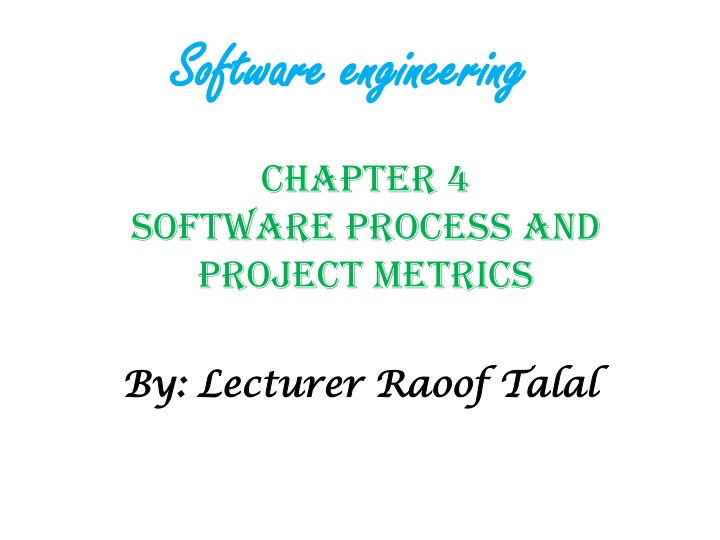
Function-Oriented Software Metrics for Project Evaluation
Learn about function-oriented software metrics that measure functionality through indirect means, like function points. Explore how complexity values are associated with data counts and the use of adjustment values to determine project complexity levels.
Download Presentation

Please find below an Image/Link to download the presentation.
The content on the website is provided AS IS for your information and personal use only. It may not be sold, licensed, or shared on other websites without obtaining consent from the author. If you encounter any issues during the download, it is possible that the publisher has removed the file from their server.
You are allowed to download the files provided on this website for personal or commercial use, subject to the condition that they are used lawfully. All files are the property of their respective owners.
The content on the website is provided AS IS for your information and personal use only. It may not be sold, licensed, or shared on other websites without obtaining consent from the author.
E N D
Presentation Transcript
Software engineering Software engineering Chapter 4 Software Process and Project Metrics By: Lecturer By: Lecturer Raoof Raoof Talal Talal
4-3-2 Function-Oriented Metrics Function-oriented software metrics use a measure of the functionality delivered by the application as a normalization value. Since functionality cannot be measured directly, it must be derived indirectly using other direct measures. Function-oriented metrics suggested a measure called the function point. Function points are computed by completing the table shown in Figure 4.3.
Five information domain characteristics are determined and counts are provided in the appropriate table location. Information domain values are defined in the following manner: Number of user inputs: Number of user outputs. Number of user inquiries. Number of files Number of external interfaces.
Once these data have been collected, a complexity value is associated with each count. Organizations that use function point methods develop criteria for determining whether a particular entry is simple, average, or complex. To compute function points (FP), the following relationship is used: FP = count total X [0.65 + 0.01 X (Fi)] Where count total is the sum of all FP entries obtained from Figure 4.3.
The Fi (i = 1 to 14) are "complexity adjustment values" based on responses to the following questions 1. Does the system require reliable backup and recovery? 2. Are data communications required? 3. Are there distributed processing functions? 4. Is performance critical? 5. Will the system run in an existing, heavily utilized operational environment? 6. Does the system require on-line data entry? 7. Does the on-line data entry require the input transaction to be built over multiple screens or operations?
8. Are the master files updated on-line? 9. Are the inputs, outputs, files, or inquiries complex? 10. Is the internal processing complex? 11. Is the code designed to be reusable? 12. Are conversion and installation included in the design? 13. Is the system designed for multiple installations in different organizations? 14. Is the application designed to facilitate change and ease of use by the user?
Each of these questions is answered using a scale that ranges from 0 (not important or applicable) to 5 (absolutely essential). Once function points have been calculated, they are used in a manner analogous to LOC as a way to normalize measures for software productivity, quality, and other attributes: Errors per FP. Defects per FP. $ per FP. Pages of documentation per FP. FP per person-month.
4-4 Reconciling Different Metrics Approaches The relationship between lines of code and function points depend upon the programming language that is used to implement the software and the quality of the design. A number of studies have attempted to relate FP and LOC measures. The following table provides rough estimates of the average number of lines of code required to build one function point in various programming languages:
Programming Language LOC/FP (average) Assembly language 320 C 128 COBOL 106 FORTRAN 106 Pascal 90 C++ 64 Ada95 53 Visual Basic 32 Smalltalk 22 Power builder (code generator) 16 12 SQL
4-5 Metrics for Software Quality The overriding goal of software engineering is to produce a high-quality system, application, or product. To achieve this goal, software engineers must apply effective methods coupled with modern tools within the context of a mature software process. In addition, a good software engineer (and good software engineering managers) must measure if high quality is to be realized.
4-5-1 an Overview of Factors That Affect Quality McCall and Cavano defined a set of quality factors that were a first step toward the development of metrics for software quality. These factors assess software from three distinct points of view: (1) Product operation (using it) (2) Product revision (changing it) (3) Product transition (modifying it to work in a different environment; i.e., "porting" it).
4-5-2 Measuring Quality There are many measures of software quality: correctness, maintainability, integrity, and usability; provide useful indicators for the project team. Correctness: A program must operate correctly or it provides little value to its users. The most common measure for correctness is defects per KLOC. When considering the overall quality of a software product, defects are those problems reported by a user of the program after the program has been released for general use. For quality assessment purposes, defects are counted over a standard period of time, typically one year.
Maintainability: it is the ease with which a program can be corrected if an error is encountered, adapted if its environment changes, or enhanced if the customer desires a change in requirements. There is no way to measure maintainability directly; therefore, we must use indirect measures. A simple time-oriented metric is mean-time-to change (MTTC), the time it takes to analyze the change request, design an appropriate modification, implement the change, test it, and distribute the change to all users. On average, programs that are maintainable will have a lower MTTC than programs that are not maintainable.
Integrity: Software integrity has become increasingly important in the age of hackers and firewalls. This attribute measures a system's ability to withstand attacks to its security. Attacks can be made on all three components of software: programs, data, and documents. To measure integrity, two additional attributes must be defined: threat and security.
Threat is the probability that an attack of a specific type will occur within a given time. Security is the probability that the attack of a specific type will be repelled. The integrity of a system can then be defined as Integrity = summation [(1 threat) X (1 security)] Where threat and security are summed over each type of attack.
Usability: The catch phrase "user-friendliness" has become ubiquitous in discussions of software products. If a program is not user-friendly, it is often doomed to failure, even if the functions that it performs are valuable. Usability is an attempt to quantify user-friendliness and can be measured in terms of four characteristics: (1) the physical and or skill required to learn the system, (2) the time required to become moderately efficient in the use of the system, (3) the net increase in productivity, (4) a subjective assessment (sometimes obtained through a questionnaire) of users attitudes toward the system.
4-5-3 Defect Removal Efficiency A quality metric that provides benefit at both the project and process level is defect removal efficiency (DRE). When considered for a project as a whole, DRE is defined in the following manner: DRE = E/(E + D) Where E is the number of errors found before delivery of the software to the end-user D is the number of defects found after delivery.
The ideal value for DRE is 1. That is, no defects are found in the software. Realistically, D will be greater than 0, but the value of DRE can still approach 1. As E increases (for a given value of D), the overall value of DRE begins to approach 1. In fact, as E increases, it is likely that the final value of D will decrease (errors are filtered out before they become defects).
DRE can also be used within the project to assess a team s ability to find errors before they are passed to the next framework activity or software engineering task. For example, the requirements analysis task produces an analysis model that can be reviewed to find and correct errors. Those errors that are not found during the review of the analysis model are passed on to the design task (where they may or may not be found). When used in this context, we redefine DRE as DREi = Ei/(Ei + Ei+1)
Where Ei is the number of errors found during software engineering activity i Ei+1 is the number of errors found during software engineering activity i+1 that are traceable to errors that were not discovered in software engineering activity i.
4-6 Metrics Collection, Computation, and Evaluation The process for metric collection, computation, and evaluation is illustrated in Figure 4.4. Ideally, data has been collected in an ongoing manner. Once measures have been collected (the most difficult step), metrics computation is possible. Depending on the breadth of measures collected, metrics can span a broad range of LOC or FP metrics as well as other quality- and project-oriented metrics.
Finally, metrics must be evaluated and applied during estimation, technical work, project control, and process improvement to produces a set of indicators that guide the project or process.






















